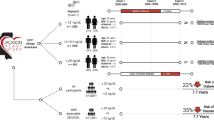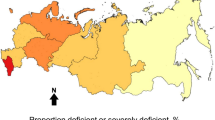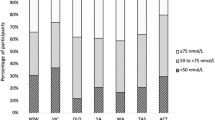Abstract
Background/objectives
Our objective was to evaluate the degree of tracking for serum levels of 25-hydroxyvitamin D [25(OH)D] over time, by using data from three previously conducted surveys of the Tromsø study collected in the years 1994/1995 (Tromsø 4), 2007/2008 (Tromsø 6), and 2015/2016 (Tromsø 7).
Subjects/methods
Subjects with valid 25(OH)D measurements in all three surveys were included. 25(OH)D z-scores were used to adjust for seasonal variation. Z-scores and sextiles were used to illustrate tracking of 25(OH)D.
Results
1702 subjects (572 males, 1130 females) fulfilled the inclusion criteria. Median (5th, 95th percentiles) age for these subjects was 55 (33, 65) years in Tromsø 4, and mean (SD) 25(OH)D levels were 57 (18) nmol/L, 59 (19) nmol/L, and 72 (21) nmol/L for Tromsø 4, Tromsø 6, and Tromsø 7, respectively. There was significant tracking of serum 25(OH)D over the 21 years period between the surveys of the Tromsø study. The correlation coefficient r between 25(OH)D z-scores from Tromsø 4 and Tromsø 6 was 0.40, and declined to 0.29 for the correlation between Tromsø 4 and Tromsø 7. Twenty-six percent of the subjects in the lowest 25(OH)D z-score sextile in Tromsø 4 were in the three highest sextiles of 25(OH)D in Tromsø 7. Similarly, 35% of those in the highest sextile in Tromsø 4 were in the lowest three sextiles in Tromsø 7.
Conclusions
The degree of tracking for serum 25(OH)D declines over time, and the use of a single serum 25(OH)D measurement as an indicator of the vitamin-D status is questionable if used in long-lasting observational studies.
This is a preview of subscription content, access via your institution
Access options
Subscribe to this journal
Receive 12 print issues and online access
$259.00 per year
only $21.58 per issue
Buy this article
- Purchase on Springer Link
- Instant access to full article PDF
Prices may be subject to local taxes which are calculated during checkout

Similar content being viewed by others
References
DeLuca HF. Overview of general physiologic features and functions of vitamin D. Am J Clin Nutr. 2004;80 6 Suppl:1689S–96S.
Holick MF. Sunlight and vitamin D for bone health and prevention of autoimmune diseases, cancers, and cardiovascular disease. Am J Clin Nutr. 2004;80 6 Suppl:1678S–88S.
Pludowski P, Holick MF, Pilz S, Wagner CL, Hollis BW, Grant WB, et al. Vitamin D effects on musculoskeletal health, immunity, autoimmunity, cardiovascular disease, cancer, fertility, pregnancy, dementia and mortality—a review of recent evidence. Autoimmun Rev. 2013;12:976–89.
Jorde R, Grimnes G. Serum cholecalciferol may be a better marker of vitamin D status than 25-hydroxyvitamin D. Med Hypotheses. 2018;111:61–5.
Sachs MC, Shoben A, Levin GP, Robinson-Cohen C, Hoofnagle AN, Swords-Jenny N, et al. Estimating mean annual 25-hydroxyvitamin D concentrations from single measurements: the multi-ethnic study of atherosclerosis. Am J Clin Nutr. 2013;97:1243–51.
Jolliffe DA, Walton RT, Griffiths CJ, Martineau AR. Single nucleotide polymorphisms in the vitamin D pathway associating with circulating concentrations of vitamin D metabolites and non-skeletal health outcomes: review of genetic association studies. J Steroid Biochem Mol Biol. 2016;164:18–29.
Bahrami A, Sadeghnia HR, Tabatabaeizadeh SA, Bahrami-Taghanaki H, Behboodi N, Esmaeili H, et al. Genetic and epigenetic factors influencing vitamin D status. J Cell Physiol. 2018;233:4033–43.
Jorde R, Sneve M, Hutchinson M, Emaus N, Figenschau Y, Grimnes G. Tracking of serum 25-hydroxyvitamin D levels during 14 years in a population-based study and during 12 months in an intervention study. Am J Epidemiol. 2010;171:903–8.
Mirfakhraee S, Ayers CR, McGuire DK, Maalouf NM. Longitudinal changes in serum 25-hydroxyvitamin D in the Dallas Heart Study. Clin Endocrinol. 2017;87:242–8.
van Schoor NM, Knol DL, Deeg DJ, Peters FP, Heijboer AC, Lips P. Longitudinal changes and seasonal variations in serum 25-hydroxyvitamin D levels in different age groups: results of the Longitudinal Aging Study Amsterdam. Osteoporos Int. 2014;25:1483–91.
Moon RJ, Crozier SR, Dennison EM, Davies JH, Robinson SM, Inskip HM, et al. Tracking of 25-hydroxyvitamin D status during pregnancy: the importance of vitamin D supplementation. Am J Clin Nutr. 2015;102:1081–7.
McKibben RA, Zhao D, Lutsey PL, Schneider AL, Guallar E, Mosley TH, et al. Factors associated with change in 25-hydroxyvitamin D levels over longitudinal follow-up in the ARIC Study. J Clin Endocrinol Metab. 2016;101:33–43.
Major JM, Graubard BI, Dodd KW, Iwan A, Alexander BH, Linet MS, et al. Variability and reproducibility of circulating vitamin D in a nationwide U.S. population. J Clin Endocrinol Metab. 2013;98:97–104.
Meng JE, Hovey KM, Wactawski-Wende J, Andrews CA, Lamonte MJ, Horst RL, et al. Intraindividual variation in plasma 25-hydroxyvitamin D measures 5 years apart among postmenopausal women. Cancer Epidemiol Biomark Prev. 2012;21:916–24.
Kluczynski MA, Wactawski-Wende J, Platek ME, DeNysschen CA, Hovey KM, Millen AE. Changes in vitamin D supplement use and baseline plasma 25-hydroxyvitamin D concentration predict 5-y change in concentration in postmenopausal women. J Nutr. 2012;142:1705–12.
Sonderman JS, Munro HM, Blot WJ, Signorello LB. Reproducibility of serum 25-hydroxyvitamin d and vitamin D-binding protein levels over time in a prospective cohort study of black and white adults. Am J Epidemiol. 2012;176:615–21.
Thorisdottir B, Gunnarsdottir I, Steingrimsdottir L, Palsson GI, Birgisdottir BE, Thorsdottir I. Vitamin D Intake and status in 6-year-old Icelandic children followed up from infancy. Nutrients. 2016;8:75.
Poopedi MA, Norris SA, Micklesfield LK, Pettifor JM. Does vitamin D status track through adolescence? Am J Clin Nutr. 2015;102:1025–9.
Berger C, Greene-Finestone LS, Langsetmo L, Kreiger N, Joseph L, Kovacs CS, et al. Temporal trends and determinants of longitudinal change in 25-hydroxyvitamin D and parathyroid hormone levels. J Bone Min Res. 2012;27:1381–9.
Zhu K, Oddy WH, Holt P, Ping-Delfos WCS, Mountain J, Lye S, et al. Tracking of vitamin D status from childhood to early adulthood and its association with peak bone mass. Am J Clin Nutr. 2017;106:276–83.
Mitchell DM, Ruppert K, Udupa N, Bassir F, Darakananda K, Solomon DH, et al. Temporal increases in 25-hydroxyvitamin D in midlife women: longitudinal results from the Study of Women’s Health Across the Nation. Clin Endocrinol. 2019;91:48–57.
Forde OH, Thelle DS. The Tromso heart study: risk factors for coronary heart disease related to the occurrence of myocardial infarction in first degree relatives. Am J Epidemiol. 1977;105:192–9.
Jacobsen BK, Eggen AE, Mathiesen EB, Wilsgaard T, Njolstad I. Cohort profile: the Tromso Study. Int J Epidemiol. 2012;41:961–7.
Jorde R, Sundsfjord J, Fitzgerald P, Bonaa KH. Serum calcium and cardiovascular risk factors and diseases: the Tromso study. Hypertension. 1999;34:484–90.
Jorde R, Grimnes G. Exploring the association between serum 25-hydroxyvitamin D and serum lipids-more than confounding? Eur J Clin Nutr. 2018;72:526–33.
Grimnes G, Almaas B, Eggen AE, Emaus N, Figenschau Y, Hopstock LA, et al. Effect of smoking on the serum levels of 25-hydroxyvitamin D depends on the assay employed. Eur J Endocrinol. 2010;163:339–48.
Sollid ST, Hutchinson MY, Fuskevåg OM, Figenschau Y, Joakimsen RM, Schirmer H, et al. No effect of high-dose vitamin D supplementation on glycemic status or cardiovascular risk factors in subjects with prediabetes. Diabetes Care. 2014;37:2123–31.
Pereira-Santos M, Costa PR, Assis AM, Santos CA, Santos DB. Obesity and vitamin D deficiency: a ≤systematic review and meta-analysis. Obes Rev. 2015;16:341–9.
Theodoratou E, Tzoulaki I, Zgaga L, Ioannidis JP. Vitamin D and multiple health outcomes: umbrella review of systematic reviews and meta-analyses of observational studies and randomised trials. BMJ. 2014;348:g2035.
Engelman CD, Fingerlin TE, Langefeld CD, Hicks PJ, Rich SS, Wagenknecht LE, et al. Genetic and environmental determinants of 25-hydroxyvitamin D and 1,25-dihydroxyvitamin D levels in Hispanic and African Americans. J Clin Endocrinol Metab. 2008;93:3381–8.
Drincic AT, Armas LAG, van Diest EE, Heaney RP. Volumetric dilution, rather than sequestration best explains the low vitamin D status of obesity. Obesity. 2012;20:1444–8.
Hyppönen E, Power C. Hypovitaminosis D in British adults at age 45 y: nationwide cohort study of dietary and lifestyle predictors. Am J Clin Nutr. 2007;85:860–8.
Acknowledgements
This article would not be possible without the work of the people engaged in the Tromsø survey and the Tromsø population taking part in the surveys year after year. We would also like to thank Yngve Figenschau at the Division of Diagnostic Services and Department of Clinical Medicine—UiT/UNN for assistance with the CV of the analyses included in the “Materials and method” section.
Funding
The study was supported by grants from the North Norway Regional Health Authorities (Grant number SFP1277-16) and UiT The Arctic University of Norway.
Author information
Authors and Affiliations
Contributions
RJ and EK were responsible for designing the protocol. JK was responsible for doing the analyses and drafting the manuscript. JK, EK, and RJ all participated in finalizing the manuscript.
Corresponding author
Ethics declarations
Conflict of interest
The authors declare that they have no conflict of interest.
Ethics approval
The Tromsø Study is approved by the Regional Committee for Medical Research Ethics (REK) and this investigation is covered by this approval.
Informed consent
All included subjects signed a written informed consent.
Additional information
Publisher’s note Springer Nature remains neutral with regard to jurisdictional claims in published maps and institutional affiliations.
Rights and permissions
About this article
Cite this article
Kubiak, J., Kamycheva, E. & Jorde, R. Tracking of serum 25-hydroxyvitamin D during 21 years. Eur J Clin Nutr 75, 1069–1076 (2021). https://doi.org/10.1038/s41430-020-00814-0
Received:
Revised:
Accepted:
Published:
Issue Date:
DOI: https://doi.org/10.1038/s41430-020-00814-0
This article is cited by
-
The association between circulating 25-hydroxyvitamin D and pancreatic cancer: a systematic review and meta-analysis of observational studies
European Journal of Nutrition (2024)
-
25-Hydroxyvitamin D reference percentiles and the role of their determinants among European children and adolescents
European Journal of Clinical Nutrition (2022)
-
Longitudinal changes in vitamin D concentrations and the association with type 2 diabetes mellitus: the Tromsø Study
Acta Diabetologica (2022)



